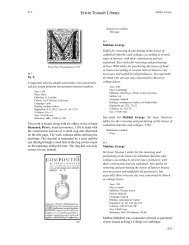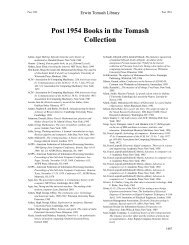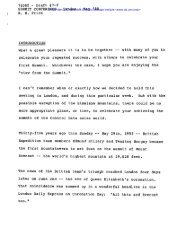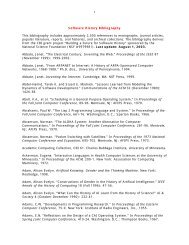B chapter.indd - Charles Babbage Institute - University of Minnesota
B chapter.indd - Charles Babbage Institute - University of Minnesota
B chapter.indd - Charles Babbage Institute - University of Minnesota
Create successful ePaper yourself
Turn your PDF publications into a flip-book with our unique Google optimized e-Paper software.
Erwin Tomash Library<br />
Buchholz, Werner Buchholz, Werner<br />
Greenwald, Sidney; R. C. Haueter and<br />
Samuel Nathan Alexander (1910–1967)<br />
SEAC, pp. 1300–1313<br />
The authors were with the National Bureau <strong>of</strong><br />
Standards, where they were instrumental in the<br />
design and construction <strong>of</strong> SEAC.<br />
Hopper, Grace Brewster Murray (1906–1992)<br />
and John William Mauchly (1907–1980)<br />
Influence <strong>of</strong> programming techniques on the<br />
design <strong>of</strong> computers, pp. 1250–1254<br />
Grace Hopper began her computer career with<br />
Howard Aiken at Harvard, but by this time<br />
she was a member <strong>of</strong> the staff <strong>of</strong> the UNIVAC<br />
Division <strong>of</strong> Remington Rand. Mauchly was<br />
one <strong>of</strong> the principle designers <strong>of</strong> ENIAC and<br />
UNIVAC I.<br />
Huskey, Harry Douglas (1916–); R.<br />
Thorenson; B. F. Ambrosio; and E. C. Yowell<br />
The SWAC - Design features and operating<br />
experience, pp. 1294–1299<br />
The authors were the principal figures in<br />
the creation <strong>of</strong> SWAC, the National Bureau<br />
<strong>of</strong> Standards computer at UCLA, their Los<br />
Angeles site. By this time, Huskey, who had<br />
started his career as a member <strong>of</strong> the ENIAC<br />
team and had worked at the National Physical<br />
Laboratory with Alan Turing for a year, was on<br />
the staff <strong>of</strong> Wayne <strong>University</strong>, Detroit.<br />
King, Gilbert W.; George W. Brown and<br />
Louis Nicot Ridenour, Jr. (1911–1959)<br />
Photographic techniques for information<br />
storage, pp. 1421–1428<br />
The authors were on staff <strong>of</strong> the International<br />
Telemeter Corporation in Los Angeles, the<br />
parent firm <strong>of</strong> Telemeter Magnetics, an early<br />
supplier <strong>of</strong> magnetic core memories. All the<br />
authors had distinguished careers: King became<br />
Director <strong>of</strong> Research at IBM, Brown was a<br />
pr<strong>of</strong>essor at UCLA and UC Irvine, and Ridenour,<br />
who had edited the MIT Radiation Laboratory<br />
series <strong>of</strong> books after the war, became the chief<br />
scientist for the Air Force.<br />
Lewis, W. D.<br />
Electronic computers and telephone switching,<br />
pp. 1242–1244<br />
Lewis was an engineer with Bell Telephone<br />
Laboratories.<br />
Palevsky, Max<br />
The design <strong>of</strong> the Bendix Digital Differential<br />
Analyzer, pp. 1352–1356<br />
Palevsky joined Bendix Aviation’s Computer<br />
Division in 1952. He later founded Scientific<br />
Data Systems (SDS), which produced the Sigma<br />
line <strong>of</strong> computers (later purchased by Xerox to<br />
form XDS).<br />
Rajchman, Jan A. (1911–1989)<br />
A myriabit magnetic-core matrix memory, pp.<br />
1407–1421<br />
Rajchman was a pioneer research engineer with<br />
RCA Laboratories. He was very interested in<br />
memory systems and designed the Selectron<br />
memory tubes used on the Johnniac computer.<br />
Ross, Harold D., Jr.<br />
The arithmetic element <strong>of</strong> the IBM Type 701<br />
computer, pp. 1287–1294<br />
Ross was a member <strong>of</strong> the staff at the IBM<br />
Engineering Laboratory in Poughkeepsie, NY.<br />
Rubin<strong>of</strong>f, Morris<br />
Analogue vs. digital computers - A<br />
comparison, pp. 1254–1262<br />
Rubin<strong>of</strong>f was an engineer with the Moore School<br />
<strong>of</strong> Electrical Engineering at the <strong>University</strong> <strong>of</strong><br />
Pennsylvania and later a faculty member.<br />
Samuel, Arthur Lee (1901–1990)<br />
Computing bit by bit or digital computers<br />
made easy, pp. 1223–1230<br />
After an early career at MIT and the <strong>University</strong><br />
<strong>of</strong> Illinois, Samuel moved to IBM in 1949,<br />
221







